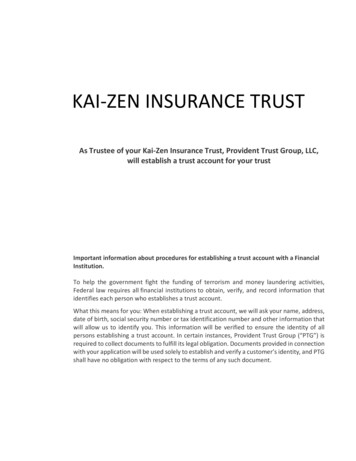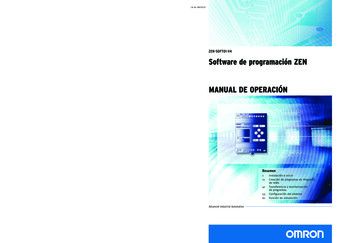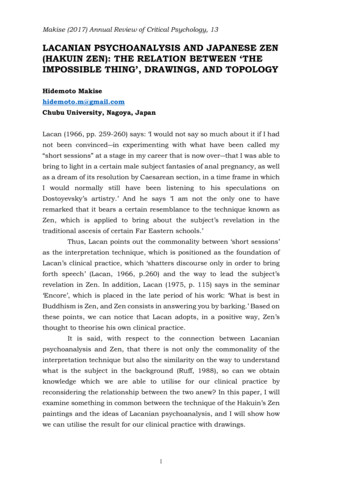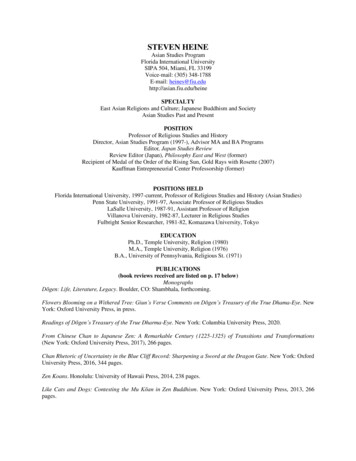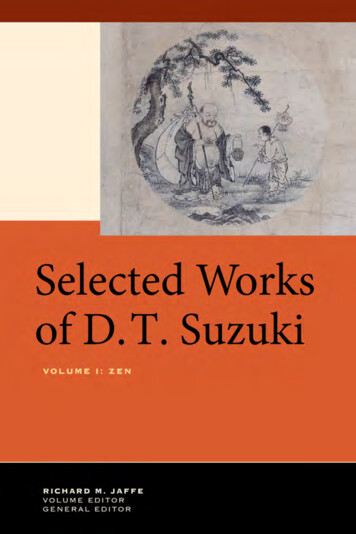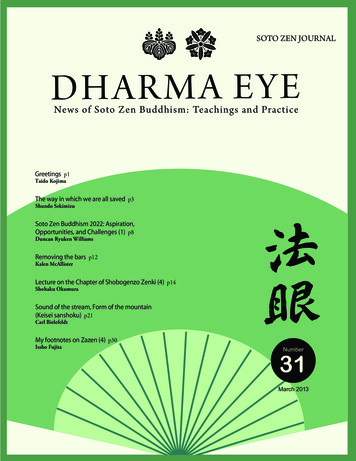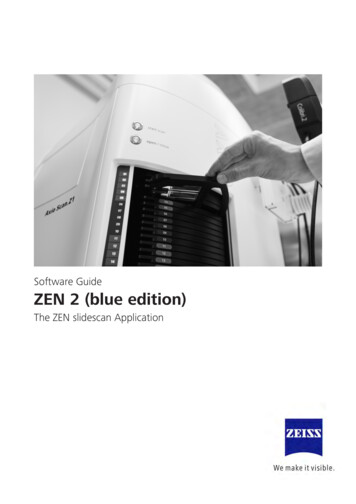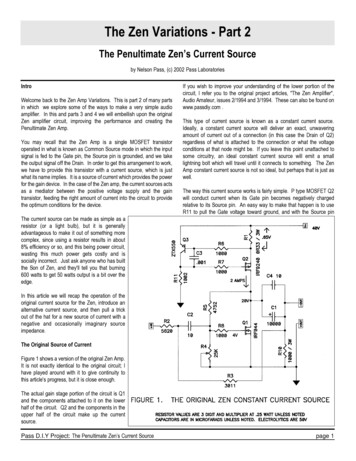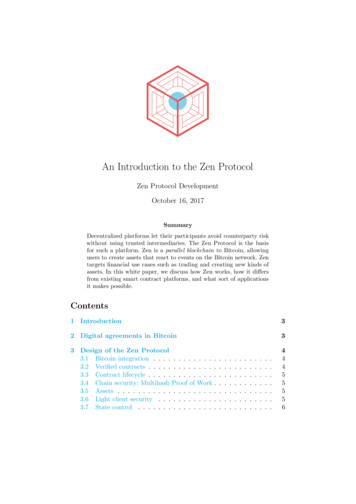
Transcription
Zen is Eternal Life
Zenis Eternal LifebyRÜSHI P.T.N.H. JIYU-KENNETTFormerly published asSelling Water by the RiverSHASTA ABBEY PRESS,MOUNT SHASTA, CALIFORNIA 96067
Third Edition—1987Fourth Edition—1999 1999 Shasta Abbey.All rights reserved.No part of this book may be reproduced in any form exceptfor brief excerpts for purposes of review without writtenpermission from Shasta Abbey, 3724 Summit Drive,Mt. Shasta, CA 96067-9102; (530) 926-4208.Originally published in 1972 as Selling Water by the River.Second edition published in 1976 as Zen is Eternal Life.Front cover: The author meditating in the Meditation Hall atDai Hon Zan Sájiji. Back cover: The author sweepingleaves in the grounds of Dai Hon Zan Sájiji.Frontispiece: The author after her Dharma Transmission ceremony.She received Dharma Transmission from the Very Reverend KoháKeidá Chisan Zenji, Chief Abbot of Dai Hon Zan Sájijiand Archbishop of Sátá Zen of the Kantá Plains.Printed in the United States of America.ISBN 0-930066-20-0Library of Congress Catalog Card Number: 99-072819The TransIndic font used to print this work is available from Linguist’s Software, Inc.,PO Box 580, Edmonds, WA 98020–0580 USA tel (425) 775–1130
To my master, the Very Reverend Kohá Keidá Chisan Zenji,late Chief Abbot of Sájiji and Archbishop of the Kantá Plains.
CONTENTS.Preface to the First EditionPreface to the Third EditionPreface to the Fourth EditionxixvixviiBook One. The Stem of the Lotus.Chapter 1Chapter 2Chapter 3Chapter 4Chapter 5Chapter 6Chapter 7Chapter 8Chapter 9History of the Buddha Accordingto Zen BeliefBasic Original Doctrines Essential to ZenGrowth of Zen from BasicHinayana DoctrineThe Necessity of Zazen orMeditation PracticeThe Necessity of Understandingthe Heart of AvalokitesvaraActivity in the Heart of SamantabhadraThe Heart of ManjusriWhat are Káans?Apostolic Succession3814233646546673Book Two. The Teachings of Dágen Zenji.Introduction to the Translations91Shushági (What is Truly Meantby Training and Enlightenment)94
viiiContentsEihei-shingi (Dágen’s Monastic Rules)Taitaikohá (How Junior Priests Must Behavein the Presence of Senior Priests)Shuryá-shingi (Trainees’ Hall Rules)Fushuku-hampá (Meal-Time Regulations)Bendáhá (How to Train in Buddhism)Tenzo-kyákun (Instructions to the Chief Cook)104104108113131145Gakudá-yájinshâ (Important Aspects of Zazen)162Shábágenzá (The Treasury-Eye of the True Teaching)Bendáwa (Lecture on Training)Sháji (Life and Death)Uji (The Theory of Time)Genjá-káan (The Problem of Everyday Life)179179196198205Kyájukaimon (Giving and Receivingthe Teaching of the Precepts)211Book Three. The Teachings of Keizan Zenji.Introduction to the TranslationsDenkároku (Transmission of the Light)Chapter 1 Shakyamuni BuddhaChapter 2 The First Ancestor, Saint MakakashyoChapter 3 The Second Ancestor, Saint AnandaChapter 4 The Third Ancestor, Saint ShánawashyuChapter 5 The Fourth Ancestor, Saint UbakikutaChapter 6 The Fifth Ancestor, Saint DaitakaChapter 7 The Sixth Ancestor, Saint MishakaChapter 8 The Seventh Ancestor,Saint BashumitsuChapter 9 The Eighth Ancestor,Saint ButsudanandaiChapter 10 The Ninth Ancestor, Saint Fudamitta217224224227231237240245248253256260
ContentsixChapter 11 The Tenth Ancestor, Saint BarishibaChapter 12 The Eleventh Ancestor,Saint FunayashyaChapter 13 The Twelfth Ancestor,Saint Anabotei MemyáChapter 14 The Thirteenth Ancestor,Saint KabimoraChapter 15 The Fourteenth Ancestor,Saint NagyaarajyunaChapter 16 The Fifteenth Ancestor,Saint KanadaibaChapter 17 The Sixteenth Ancestor,Saint RagorataChapter 18 The Seventeenth Ancestor,Saint SágyanandaiSankon-zazen-setsu (The Three Types of PersonalitiesResulting from Training)264AnnotationsGlossaryIndexAbout the AuthorAbout the Order of Buddhist ContemplativesAbout the Monasteries of the Order299301341349351353267269273277282285290297
PREFACE TO THE FIRST EDITION.In 1186 military government, under Yoritomo Minamoto,was established in Japan and, with it, came one of the greatestchanges ever experienced in the history of that country. Up untilthat time the seemingly pleasure-loving aristocracy in Kyotohad written their poems, painted pictures and sung, apparentlyforgetting that the peasantry existed; degeneracy appeared tobe in the air. The Buddhist hierarchies had enjoyed politicalsupport in return for mysterious and beautiful ceremonieswhich were seemingly more or less devoid of genuine spirituality. Then, with the fall of the aristocracy, the temples andmonasteries found themselves on their own, a prospect veryfew seemed to be able to adapt to.Amidst all the turmoil a new spiritual force began to arise.In the year 1191, Eisai Zenji, a Japanese Buddhist priest,returned from China and established the Rinzai school ofZen: he had spent four years studying under Master Eshá. Thenew and vital school of Buddhism that he brought with himwas like a beacon of light shining in the religious darkness ofmediaeval Japan.The káan system of the Rinzai school was itself a fairlynew development in the history of Zen. It was mainly throughthe eloquent master Daie Sáká, in the early part of the twelfthxi
xiiPreface to the First Editioncentury, that it had become widely used in China. The káanexercise, with its shouting, kicking, crying and beating, culminating in the sudden understanding of kenshá, attracted theyoung samurai of Japan who seemed to have quickly absorbedits methods into their own discipline.Shortly before Eisai’s death, a young trainee, namedDágen, began studying under the aged master. Upon the deathof his teacher, Dágen, who was not satisfied even with theRinzai teachings, found it necessary to travel to China in orderto further his studies. There he found the “serene reflection”type of meditation practiced by the Sátá school of Zen and itis with these teachings, which he brought back to Japan, thatthis book is concerned.Sátá Zen followed mainly the Indian tradition and wasthe religion of the ordinary person, man or woman. In his writings, after his return, Dágen proclaimed that there was no difference between the meditations of a man and a woman, a richperson and a poor one, everyone being able to find peace andfreedom if he truly sought it. It is because of its apparently simple approach, the very opposite, to me, of the approach ofRinzai, that I have chosen Sátá for myself.Under his Chinese master, Nyojá, Dágen learned that Sátámasters were not bound by any one system of teaching: theypreferred to use kaleidoscopic teaching methods and to allowthe káan to develop naturally in the daily life of the trainee, ashis spiritual understanding ripened, rather than force his growththrough the unnatural tension created by a fixed system ofkáans. It was in 1227 that Dágen returned to Japan to teach the“new” Sátá system; so called despite the fact that Sátá is theoldest of the three Zen schools.During his lifetime, Dágen realised that the time forspreading Sátá Zen in Japan had not yet come so he spent mostof his life organising small communities. It is for this reason,
Preface to the First Editionxiiiand this reason only, that Sátá Zen had to wait several generations before it was to enjoy widespread acceptance in Japanunder the aegis of Keizan Zenji. Anesaki tells us, in his Historyof Japanese Religions, that the times were ripe for a new andvital religion, Rinzai seemingly having, by then, degeneratedinto a means of artistic religious expression rather than beinga source of real spiritual help for the masses who were in direneed of it.Until the time of Keizan, Dágen’s Zen seemingly had clungto its Chinese heritage thus alienating itself from the commonpeople of Japan. Keizan brought the old ideas of Buddhism intoline with the new spirit of the times—and in so doing exemplified one of Dágen’s greatest teachings—by his insistence thatZen could survive only if it came alive for the time in whichits adherents were living. To this end he, like Dágen, taught themost advanced forms of hygiene and living habits then extant,blending them with the culture of the Japanese people and theancient spirit of Zen so that every act of daily life became anact of religious understanding. Through this simple process SátáZen spread throughout the country until today it is the secondlargest school of Buddhism in Japan, its teachings keeping everin step with the times and yet retaining their original spirit.I studied at the London Buddhist Vihara and was a lecturer at the London Buddhist Society. It was while studyingBuddhist history that I discovered that all the seemingly knowngreat Zen masters appeared before the Sátá and Rinzai linesseparated, although there were many good masters later in bothlines. I spent time in Chinese temples of the Rinzai school inMalacca, Singapore and Hong Kong but felt that its teachingsdid not go far enough; it therefore seemed only natural that Ishould devote my fullest energies to pursuing the Sátá way;after all, this had been my original intention. This I did for seven
xivPreface to the First Editionyears and seven months in Japan with a three-month return visitto Malaysia during this time.There is a Japanese saying that, whilst Rinzai is for thegenerals, Sátá is for the farmers. It would appear that, whereasRinzai Zen is much better known for its religious arts than forits genuine spiritual help for the ORDINARY man and woman,Sátá Zen teaches the way for every living person, whether theybe student, factory worker or executive, to find peace and freedom in everyday life. The farmer in his fields can apply SátáZen to his daily life just as much as can the queen of Englandor the president of the United States; all find complete peaceof spirit without the stress or strain they would experienceshould they try to reach the same state through the Rinzai káanmethod.Bearing these facts in mind, Sátá Zen is ideal for thepresent-day religious revival in America. Both Dágen andKeizan were far in advance of their own day and age and, insome ways, are still in advance of ours; what they wrote andtaught is as applicable now as it was when they wrote it.Although the old forms of many of the ceremonies are stillkept and performed intact, their meaning and spirit are abreastof the times in which we live and this vitalises them in a wayno other religion, at present extant, seems to me to be able toequal.At a time when the young are seeking a religion that meanssomething to them personally, rather than one that requires rigidadherence to doctrine and old rules, Dágen’s insistence uponfinding freedom, perfection and peace of spirit within oneself,amidst the struggle of everyday life and within the structureand times in which one lives, is as relevant as it was when helived and it is my certain knowledge of this that has led me toplace the following work before the public.
Preface to the First EditionxvI beg the reader’s pardon for the inadequacy of this book;whatever merit it has must be given to the Buddha, Dharmaand Sangha; may you be peaceful and happy.Ráshi P.T.N.H. Jiyu-KennettAbbess of Shasta Abbey, California,and former Foreign Guestmaster,Sáji Temple, Yokohama, Japan.October, 1971.
PREFACE TO THE THIRD EDITION.After seventeen years in America, much of what has beensaid in various places in this book, concerning Japanese temples and Japanese ways, is no longer relevant for we have foundcomplementary equivalents that preserve the spirit of theteachings of Dágen and Keizan whilst not being bound by theirethnic traditions. This has led us to revert to the original translation of the Denkároku in this edition as well as to the original form and title of the book itself; however, for the sake ofcontinuity, we are retaining the preface to the first edition,slightly altered, so as to make the transition from East to Westeasier. I believe it was Kohá Zenji’s fond hope that, when Zencame to America, it would come as a pure bride, unclutteredby attachment to its former ethnic connections. After seventeen years, we now know that this is possible, but we did notwish to remove anything whatsoever from the actual writingsof Dágen and Keizan concerning Japan and the Orient so thesereferences have remained although we now use Americanequivalents when teaching. This edition contains a revised glossary and index.Ráshi P.T.N.H. Jiyu-KennettJune, 1987.xvi
PREFACE TO THE FOURTH EDITION.Reverend Master Jiyu-Kennett passed away on November6, 1996. We, her disciples, are honored to be able to bring outthis fourth edition of her first book, in the spirit of continuingto make the offering of teaching which epitomized her life rightto the end.We have naturally wished to make as few changes as possible in this edition, so that first time readers will be able to seeher words directly and get a true sense of both the flavor andsubstance of her teaching. To this end, there are only threechanges of any significance between the third edition and thisone. First, the cover has been redesigned so as to make the bookmore accessible. Second, the sections about the author andabout the Order she founded have been revised to reflect eventsthat have occurred since the third edition.The third change has been to reorganize the chapters ofBook Two so that they are grouped under the names of the volumes of Dágen Zenji’s work in which the originals are to befound. This has been done to facilitate finding other translations of the same works, as Rev. Master Jiyu-Kennett regardedthe translations she worked upon as complementary to othertranslations. One of these moves, however, may surprise readers of previous editions of this book, and that is the move ofthe translation of the Kyájukaimon from the section on thexvii
xviiiPreface to the Fourth Editionteachings of Keizan Zenji to the section on the teachings ofDágen Zenji. This change has an interesting story behind it.When Rev. Master Jiyu was in Japan, this text was customarily referred to as “Keizan’s Kyájukaimon,” so she naturally assumed that Keizan Zenji was its author. A few months beforeher death, our translator, Rev. Hubert Nearman, reported to mea most odd thing: in his research for another project, he hadneeded to refer to the original text of the Kyájukaimon andcould not find it among the collected works of Keizan but didfind it in the works of Dágen. Intrigued by this, Rev. MasterJiyu asked that Rev. Hubert research the matter further. Unfortunately she passed away before that research was completed, but this is what he found.There are two versions of the text: one in Chinese, onein Japanese. The latter is not strictly speaking a translation ofthe former, but rather a reworking of the order of the characters and the addition of certain modifiers so as to make thetext comprehensible to readers of Japanese. This Japanese textbears an inscription indicating that it was done by KeizanZenji, and further noting that the text itself was not originalto Dágen but was rather Dágen’s written version of a mucholder, orally transmitted, work. Since scholars have not located any Chinese source for the commentaries to the preceptsthat form part of the Kyájukaimon, it is likely that these are,indeed, original writings of Dágen.So, what Rev. Master Jiyu knew as “Keizan’s Kyájukaimon” was probably the Japanese version of the text. In onesense it does not really have an “author,” belonging to oral tradition, but we felt that Rev. Master Jiyu would probably havewanted to follow the tradition of giving primary credit for thetext to Dágen, since he was the first to write it down and is theprobable author of the commentary: hence the change we havemade in its placement in this edition.
Preface to the Fourth EditionxixWe offer this edition to you in the hope that it may be asuseful and inspiring to you as it has been to us.Rev. Daizui MacPhillamyfor the Order of Buddhist Contemplatives.September, 1998.
BOOK ONE.THE STEMOF THE LOTUS.All men know suffering which is as the mud in which the lotustakes its root: all men know the lotus blossom which gazes atthe heavens. Few men indeed know how to nourish the root ofTrue Religion within themselves in the mud of ignorance thatsurrounds them and fewer still know how to make that root flourish and grow the long stem needed in the dark water before theflower can bloom in the clear light of day. In this introductionI am attempting to show how to grow the long stem of the lotus,from the root to the blossom, for the stem of the lotus and Zentraining are identical.
CHAPTER 1.THE HISTORY OF THE BUDDHAACCORDING TO ZEN BELIEF.On the full-moon day of May, in 623 B.C., Prince Siddhartha Gautama, afterwards Shakyamuni Buddha, was bornin Lumbini Garden, in Kapilavastu, on the borders of Nepal,His family being of the aristocratic Sakya clan or caste. His father was King Suddhodana and His mother Queen MahaMaya: seven days after His birth His mother died and His aunt,Maha Prajapati, His mother’s younger sister, who was alsomarried to King Suddhodana, became His foster mother. Asita,who was an intimate friend of the king, visited the palace tosee the Child but, when the Baby was brought to him, the Childplaced His feet in the ascetic Asita’s matted hair. Asita, foreseeing by this action the Child’s future greatness, rose fromhis seat and saluted Him with gasshá as did also the king. After this, Asita first smiled and then wept for he knew thatGautama was the Buddha that was to come and that he, owingto his own prior death and rebirth in a formless realm, couldnot be alive to benefit from the Buddha’s superior wisdom.On the fifth day the Child was named SiddharthaGautama, which means “wish-fulfilled,” and many learnedBrahmins were invited to the palace for the naming ceremony. Among them were eight distinguished men, seven ofwhom, on examining the Child’s characteristics, raised twofingers thus giving a double interpretation that He would be3
4The Stem of the Lotuseither a universal monarch or a Buddha: the youngest and mostlearned, however, Kondanna, raised only one finger, thusfirmly declaring that He would definitely retire from the worldand become a Buddha.During the ploughing festival the future Buddha had anunprecedented mental experience which served as the key toHis enlightenment. This festival was arranged to encourage agriculture and both nobles and commoners, in gala dress, participated. The Child was left on a screened and canopiedcouch, beneath a rose-apple tree, to be watched by His nurseshowever, at the climax of the festival, the nurses stole away towatch and the Child, sitting cross-legged and concentrating onthe inhalation and exhalation of His breathing, gained onepointedness of mind which is the first ecstasy. The Prince wasso absorbed in meditation when the nurses returned that, struckwith awe, they told the king who came and saluted his son forthe second time.After an excellent education and being specially trainedin the art of warfare, Gautama married His beautiful cousin,Yashodhara, both of them being sixteen years of age. Thereafter He led a luxurious life, unaware of the life of tribulationled by most people outside the palace. He had three palaces soas to be able to enjoy His life to the full; each was for a different season, hot, cold or rainy. Renunciation of luxury and pleasure was not yet within His mind.However, His contemplative nature and boundless compassion did not allow Him to enjoy royal pleasures as othersdid. He knew no woe but He had a deep desire to witness theway of life of humanity in general even amidst His own comfort and prosperity.One day He went outside the palace and saw the darkerside of the life of men. First He saw a decrepit old man, then adiseased person, later a corpse and, finally, a dignified hermit.
History of the Buddha According to Zen Belief5The first three of these sights showed Him the inexorable nature of life and the universal sickness of humanity; the fourthshowed Him the means of overcoming this and the way to attaining calm and peace. Thereafter, realising the uselessnessof sensual pleasures and the value of renunciation, He decided to leave the world. It was after this decision that He heardof the birth of His son and, regarding the child as an impediment rather than a blessing, named him Rahula.He now realised that the time was ripe for His departureand, after ordering Channa to saddle Kanthaka, His horse, Hestood on the threshold of the princess’s chamber and cast a dispassionate glance at His wife and child. His compassion dominated Him however even at the moment of His parting so thatHe stole away at midnight, attended only by Channa, to become a penniless wanderer at the age of twenty-nine.After travelling for a long way He rested on the far bankof the river Neranjara and there shaved His head, giving Hisgarments and ornaments to Channa to take back to the palace.He now adopted the simple yellow garb of an ascetic and leda life of voluntary poverty as a homeless beggar.He commenced His search for calm and peace by studying with Arada Kalama, an ascetic of repute who, after hispupil’s developing the seventh Arupa Dhyana, or the Realmof Nothingness, regarded Him as his equal. The future Buddha was not satisfied, however, with mere mental concentration so He went to Udraka Ramaputra with whom He developed the final mental stage of the Realm of Neither Perceptionnor Non-Perception. Since, in those days, the ancient sagescould proceed no further than this in mental development, theteacher invited Him to take full charge of all his disciples.Finding that there seemed to be no-one competent toteach Him, since all were enmeshed in ignorance, Gautamagave up looking for external help from teachers since He
6The Stem of the Lotusrealised that Truth and peace are to be found within oneselfand not gained from another. Thereafter He wandered in thedistrict of Magadha arriving eventually at Uruvela. Hearingof His renunciation, Kondanna, who had foretold His destinyat His birth, and four sons of the other sages who had beenpresent at the same time, Bhaddiya, Vappa, Mahanama andAssaji, also renounced the world and joined Him. Asceticismwas practiced very severely in those days in India and Gautamapracticed all forms of austerity to such an extent that Hisdelicate body was reduced almost to a skeleton but the greaterHis torments the further His goal receded, their only resultbeing exhaustion.Then came Mara suggesting to His mind that He live alife of merit which would involve Him in sacrifices and celibacy, but the future Buddha discarded these things since sensedesires, aversion, hunger, thirst, craving, sloth, torpor, fear,doubt, distractions, obstinacy, profit, praise, honour, falsefame, the extolling of oneself and contempt of others He knewto be the weapons of Mara. Resolving that it would be betterto die in the battle against such things rather than to live vanquished, He dismissed these possibilities and made firm Hisdetermination to reach Buddhahood.It was after this decision that He abandoned selfmortification as futile and adopted the middle path for He nowrealised that the way to enlightenment was the one of simplysitting which He had discovered when He was a child and Hetherefore took food. This so disgusted the five ascetics whowere with Him that they deserted Him on the spot saying Hehad become indulgent. After a substantial meal, offered bySujata, He resolved just to sit.Seated under the famous pipal tree, at Buddha Gaya, withHis mind tranquil and purified, He developed the supernormal knowledge of the true way to the destruction of the
History of the Buddha According to Zen Belief7passions and, comprehending things as they truly are, realisedHis original enlightenment exclaiming, “I was, am and willbe enlightened simultaneously with the universe.” He wasthirty-five.He was born human and He lived and died as a man; however, although He was human and neither deified nor immortal, He became an extraordinary man. He must not be thoughtof as an incarnation of Vishnu nor of any other god and Hispersonal salvation cannot save others. “You yourselves mustmake the exertion; the Buddhas are only teachers,” was one ofHis sayings and, “Remember thou must go alone; the Buddhasdo but point the way,” is another famous quotation. Instead ofplacing an unseen, almighty god over man, and making himsubservient to such a belief, Shakyamuni Buddha raised theworth of mankind. Selfless service and the equality of all menand women are the corner-stones of His teaching.
CHAPTER 2.BASIC ORIGINAL DOCTRINESESSENTIAL TO ZEN.Anatta (No-soul or individual self).Apart from mind and matter which constitute this socalled being, which we know as man, there is no immortalsoul, or eternal ego, with which we are either gifted or haveobtained in a mysterious way from a mysterious being orforce. The Buddhist doctrine of rebirth should be distinguished from the theory of re-incarnation, or that of transmigration, for Buddhism denies the existence of an unchangingor eternal soul. The forms of man or animal are merely thetemporary manifestations of the life force that is commonto all. “Being” is only a concept used for conventional purposes. Birth is simply the coming-into-being of a psychophysical existence. Just as a physical state is conditioned bya preceding state as its cause, even so the coming-into-beingof this psycho-physical life is conditioned by causes anteriorto its birth. As one life-process is possible without a permanent thing passing from one thought-moment to another, soa series of life-processes is possible without anything totransmigrate from one life to another. This body dies; thereis no less life-force; nothing transmigrates from one body toanother. The future being there will be conditioned by thepresent life force here. A new being is neither absolutely the8
Basic Original Doctrines Essential to Zen9same as its predecessor (since the composition is not identical) nor entirely different, being the same stream of life-forcewhich, like electric current, can be tapped when a new bulbis plugged in, so as to give light, but which is unseen, whenthe bulb breaks, until a new one is again plugged in. Just aswith the electricity there is no lack of current when a bulbbreaks, merely the necessity for a new bulb, so with rebirththere is a continuity of a life force which manifests itself inbirth and seems invisible in death; just that and nothing more.Karma.Action or deed, either good or bad. The law of moral causation; action and reaction in the ethical realm; it includes bothpast and present actions. It is not fate; not predestination imposed by some mysterious power to which we must helplesslysubmit. It is one’s own doing which reacts on one’s own egocentric self so it is possible for us to direct the course of ourkarma. Karma is action, and vipaka is its reaction: thus, causeand effect. Karma, being a law in itself, needs no lawgiver;it operates in its own field without the intervention of an external, independent ruling agency. Inherent in it is the potentiality of producing its due effect: the effect already bloomsin its cause. Karma, good or bad, is caused by not knowingthings as they truly are, and ignorance and craving are thechief causes. “No doer is there who does the deed, nor is thereone who feels the fruit;” this can be understood clearly afterdeep and true meditation thereon. Our will, or ego, is itselfthe doer of karma, and feeling is itself the reaper of the karmicfruit; apart from these mental states, there is none to sow andnone to reap. Karma is not “stored” somewhere either in theconsciousness or in the body; being dependent on mind and
10The Stem of the Lotusmatter, it manifests itself at the opportune moment and is anindividual force which is transmitted from one existence toanother. Not everything is due to karma, otherwise a personwould always be bad if it was his karma to be bad. Seasonalphenomena, the order of germs and seeds, the theory of cellsand genes, the order of act and result, natural phenomena suchas gravitation and other similar laws of nature, the order ofmind and the psychic law such as the processes of consciousness and arising and perishing of consciousness are all lawsin themselves. Karma, which is the third of these five universal laws, helps, with the other four, to account for diversityin the world. Karma gives hope, self-reliance, consolation andmoral courage to a Buddhist; it teaches individual responsibility and explains the problem of suffering, the mystery ofso-called fate and predestination in other religions and, aboveall, the reason for the inequality of mankind.Rebirth.Past karma conditions the present birth, and presentkarma, in combination with past karma, conditions the futurebirth. As stated earlier, rebirth must be distinguished from reincarnation or transmigration since an unchanging or eternalsoul is non-existent; since there is no individual “I” to think,there is nothing to be reborn.The Four Noble Truths.Shakyamuni Buddha saw old age, disease, death (i.e. threeaspects of suffering) and the priestly life when He went outside the palace. Thereafter suffering became His all-absorbing
Basic Original Doctrines Essential to Zen11problem and He entered the priesthood in order to work on it.He discovered the answer to His problem in the Four NobleTruths and, inadvertently, enlightenment. The first of theseTruths was that of the existence of suffering. Birth, decay,death, sorrow, lamentation, pain, grief, despair, not to getwhat one wants and existence itself as the world knowsexistence, are suffering; all these things are karmicallyacquired. The Three Characteristics, anicca (transiency),dukkha (suffering), anatta (no separate self), can be understood by experience but cannot be adequately explained inwords; the three warnings, sickness, old age and death, mustcome to all and the beginning of the wheel of existence isinconceivable. The second Truth is that of the origin of sufferi
Book One. The Stem of the Lotus. Chapter 1 History of the Buddha According to Zen Belief 3 Chapter 2 Basic Original Doctrines Essential to Zen 8 Chapter 3 Growth of Zen from Basic Hinayana Doctrine 14 Chapter 4 The Necessity of Zazen or Meditation Practice 23 Chapter 5 The Necessity of Understanding the Heart of Avalokitesvara 36
